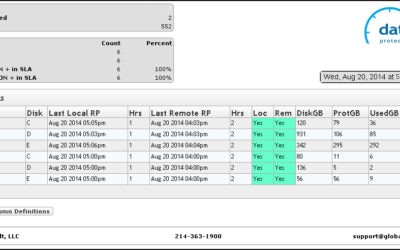Backing Up Data
It’s one of an IT department’s and computer users worst nightmares: having to reinstall an operating system. You KNOW that it won’t be the same. You’ll lose personalized settings. You’ll spend hours updating drivers. You’ll overwrite files. It will be messy. You will not be a nice person. If you’re doing it for someone else, they will be unappreciative of the “upgrade” because nothing will run the same again.
The thing is, you never really know when you might have to reinstall an OS, so it’s always wise to prepare for that fateful day in advance. Take some screenshots of start-up menus, control panel, firewall, etc. And download your installers in advance, that will allow you to reinstall cleanly to the new OS.
Now the task of backing everything up. If you’re a small business, there are four logical steps you need to take before you begin your data backup project:
1) Identify and record all data and its locations – consider the obvious (desktops, laptops, servers, etc) but don’t overlook smart-phones, tablets, websites and social network properties.
2) Determine your data backup solution. How much data needs to be backed up, how often you need to back it up, is there any data that falls under data retention laws, what is your budget and how will you ensure the backups are encrypted?
3) Where will you be backing up data? An online computer backup solution provides additional security against any site-wide disaster. Online data backup solutions are often automated as well so you don’t have to have additional staff dedicated to your back-up plan.
4) Determine how you will monitor the accuracy and reliability of the backups. (online data back up or on-site), and when and how you will assess what data needs to be backed up (additions, changes) on a regular basis.
Whatever you do, do not forget to backup these essential files or your online life could get pretty uncomfortable: your website files, your passwords and your calendar…
More Data Backup Posts
What is Cloud Disaster Recovery (Cloud DR)?
What Is Cloud Disaster Recovery? Often shortened to Cloud DR, disaster recovery is a plan put into place in case a disaster hits. Cloud DR refers to the component in your disaster recovery plan that involves the use of a cloud backup environment. The Cloud Component...
Data Protection Dashboard Provides Easy to Use Status Window
Global Data Vault Web Portal At Global Data Vault, we ensure the quality of your recovery environment through constant monitoring. Nothing is more important to your business operations than your data and the systems that support it. Not only do we monitor your...
Developing a Data Retention Policy: What to include in your data backup?
(The second in three part series on Developing an Effective Data Retention Policy. In our previous article, Developing an Effective Data Retention Policy, we outlined the history of and comparison of tape backup environments to disc backup environments. Understanding...
Data Backup: Developing an Effective Data Retention Policy
(The first in a three part series. Jump to Part Two: What do you HAVE to back up?) Archiving one’s data is a challenge for every business, whether the business is a billion dollar enterprise or a SOHO. Data loss can be devastating to the profitability of any...




0 Comments